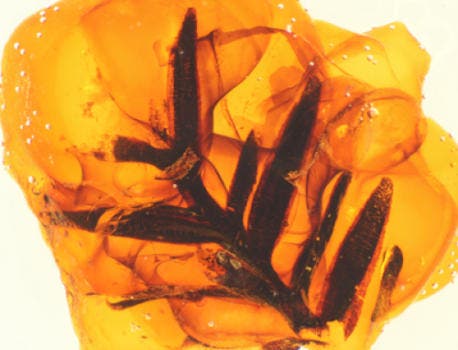An international team of researchers led by Ralf Tappert, from the University of Innsbruck, reconstructed the composition of Earth’s atmosphere of the last 220 million years by analyzing modern and fossil plant resins. Their results indicate that atmospheric oxygen was considerably lower in Earth’s geological past than previously assumed – providing valuable information about current climate models, and questioning some of the current theories about the evolution of climate and life, including the causes for the gigantism of dinosaurs.
Atmospheric oxygen and resin
Scientists face major challenges when reconstructing atmospheric compositions in Earth’s geological past because of the lack of sample material. Ice cores are very reliable, but they only go so far (usually tens or hundreds of thousands of years), and geologic phenomenona (such as volcanic ash, Stromatolite and Banded-iron Formation) offer only some approximations.
However, one of the few organic materials that may preserve reliable data of Earth’s geological history over millions of years are fossil resins (e.g. amber). They have been present in various forms for hundreds of millions of years and can offer valuable information.
“Compared to other organic matter, amber has the advantage that it remains chemically and isotopically almost unchanged over long periods of geological time,” explains Ralf Tappert from the Institute of Mineralogy and Petrography at the University of Innsbruck.
In order to fully analyze it and make the most of the samples, the team gathered researchers from several fields, including mineralogy, chemistry and paleontology. They mostly focused on the preserving properties of plant resins, caused by polymerization, for their study.
“During photosynthesis plants bind atmospheric carbon, whose isotopic composition is preserved in resins over millions of years, and from this, we can infer atmospheric oxygen concentrations,” explains Ralf Tappert
The information comes about oxygen concentration comes from the isotopic composition of carbon or rather from the ratio between the stable carbon isotopes 12C and 13C. The 12C/13C ratio is extremely important in studying the climate and atmospheric conditions in geologic times; a change in the ratio in the remains of plants indicates a change in the amount of photosynthetic activity, and thus in how favorable the environment was for the plants.
Oxygen, climate and life
The research team analyzed a total of 538 amber samples from well known deposits worldwide, with the oldest samples being approximately 220 million years, recovered from the Dolomites in Italy. The team also compared the resin samples with modern ones, to test the validity of their data. The results of this comprehensive study suggest that atmospheric oxygen during most of the past 220 was considerably lower than today’s 21 percent, raising major question marks about the data at the basis of most climate studies and models.
“We suggest numbers between 10 and 15 percent,” says Tappert. These oxygen concentrations are not only lower than today but also considerably lower than the majority of previous investigations propose for the same time period. For the Cretaceous period (65 — 145 million years ago), for example, up to 30 percent atmospheric oxygen has been suggested previously.
The team also confirmed some of the current theories, like for example the connection between high CO2 levels and high temperatures.
“We found that particularly low oxygen levels coincided with intervals of elevated global temperatures and high carbon dioxide concentrations,” explains Tappert.
He actually suggests that there may be a connection between oxygen and carbon levels, a ratio which is instrumental in our planet’s climate.
“Basically, we are dealing here with simple oxidation reactions that are amplified particularly during intervals of high temperatures such as during the Cretaceous period.”
Another interesting result of this study is the impact of the atmospheric oxygen on Earth’s life. Many theories on gigantism claim that as oxygen levels start to grow, so do animal sizes – but according to this study, this idea is invalid, as oxygen level during the Jurassic, for example, weren’t particularly high.
“We do not want to negate the influence of oxygen for the evolution of life in general with our study, but the gigantism of dinosaurs cannot be explained by those theories.
Journal Reference:
- Ralf Tappert, Ryan C. McKellar, Alexander P. Wolfe, Michelle C. Tappert, Jaime Ortega-Blanco, Karlis Muehlenbachs.Stable carbon isotopes of C3 plant resins and ambers record changes in atmospheric oxygen since the Triassic. Geochimica et Cosmochimica Acta, 2013; 121: 240 DOI: 10.1016/j.gca.2013.07.011










